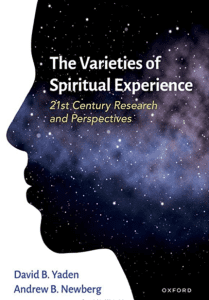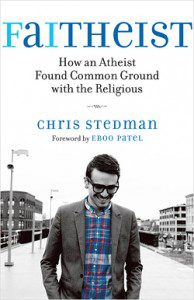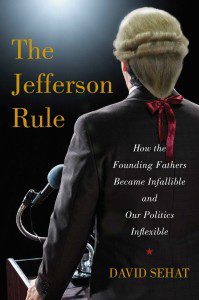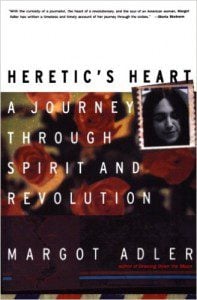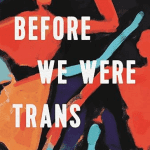I believe the future of religion is a spirituality that is interfaith at its core….. The good news is that people, at least in the developed world, are rejecting cultural and religious exceptionalism. By religious exceptionalism I mean the conviction that my religion possesses the truth and, by extension, yours is false…. Religions are not all the same, of course. Yet certain common themes and core values emerge in all of them. Among these are compassion, community, the practice of a spiritual discipline, and the pursuit of a difficult path toward a new level of consciousness…. A new interfaith, multifaith spirituality is struggling to be born.
A few years ago, The New Yorker ran a cartoon that pictured people streaming joyously out of a traditional looking church building. Each of the many congregants as depicted with a giant foam finger on their hand with the index finger raised, indicating the number 1. These giant foam hands with “#1” emblazoned on them are all raised proudly in the air. The caption reads, “It’s true — we totally have the best religion!”
In contrast to this idea that any one religion could be the best, Peter Morales, the president of the Unitarian Universalist Association, is one of many people advocating that, “A new interfaith, multifaith spirituality is struggling to be born.” One reason I am drawn to Unitarian Universalism is that it is explicitly multifaith. Whereas the word interfaith is often used to indicate dialogue between individuals, who are rooted in separate traditions (a Christian dialoging with a Muslim, a Buddhist dialoguing with a Hindu, a Sikh dialoging with a Jew), a multifaith path seeks to be rooted in multiple perspectives. UUs drawn from six broad sources:
- direct experience,
- words and deeds of prophetic men and women,
- wisdom from the world’s religions,
- Jewish and Christian teachings,
- humanist teachings (reason and science), and
- Earth-centered traditions.
A critic might ask, is it really possible to be rooted in multiple perspectives? For one response, we could turn the clock back more than 150 years to quote our transcendentalist forebear Walt Whitman from his poem “Song of Myself”: Do I contradict myself? / Very well then I contradict myself, / (I am large, I contain multitudes.)” I love that answer. It’s generous, robust, expansive, open, playful.
But some of you may recall my post a few weeks ago on “Building Your Own Theology,” which named a potential criticism that UUs and other individuals and groups on a multifaith paths are just “theologically promiscuous.” The word promiscuity, of course, has connotations of being indiscriminate, transient, and casual. But that pejorative characterization does not have to be the case with a healthy multifaith practice.
In my experience of moving from a Progressive Christian context to a Unitarian Universalist context, there is a paradigm shift that happens when you move from interfaith to multifaith, from dialogue between two different traditions to one tradition that seeks to fully embrace multiple traditions.
I will freely confess, however, that one of the greatest temptations for most multifaith individuals and communities is to stay in the shallow end of the pool: to dip our toes into various world religious without ever taking a plunge into the deep end of full, immersive, extended experience. But I think the risk is worth it. I have spent much time in Christian circles, and I have heard so many criticisms like “Going to church doesn’t make you a Christian any more than being in a garage makes you a car.” (Loving God, your neighbor, and your enemies makes you more like Jesus.) There are similar criticisms in other traditions such as buying expensive Buddhist paraphernalia is unlikely to suddenly make you enlightened. (Spending time meditating with butt on the cushion is more much likely to contribute to the awakening Buddha experienced.)
I have immense respect for my friends, who are called to walk in mostly Buddhist circles or Christian circles or Pagan circles or Secular Humanist circles and who go deeply into those traditions in open-minded, compassionate ways. But from what I have seen, there are approximately the same number of dabblers in circles that are almost exclusively Buddhist, Christian, Pagan, or Humanist as there are in multifaith circles. Likewise, there are approximately the same number of hardcore adherents in those settings. I suspect that is the case because all of those groups — whether exclusive, interfaith, or multifaith — are all composed of human beings with all the same foibles, weaknesses, and good intentions that aren’t always accompanied by an ideal follow-though.
That being the case, if I were asked to choose my preferred default setting, I would choose multifaith over interfaith every time. I see our pluralistic age as an invitation to have more religious communities whose starting point is multifaith and interspiritual. Similarly, when I think about the religious context in which I would like to raise the hypothetical children that Magin and will likely one day have, I see a great strength in them learning from day one to move naturally, easily, and authentically (even simultaneously) between multiple religious traditions and experiences. I see that multi-religious potential as a tremendous asset in our postmodern world akin to growing up speaking multiple languages.
It is also essential for me to highlight the ingredient that I think makes all the difference in whether one stays at the shallow end of the pool or risks diving into the deep end: the First Source, “direct experience” — what you know as true not because you heard it secondhand, but because you experienced it firsthand for yourself. More than 300 years ago, George Fox (1624 – 1691), founder of the Society of Friends (commonly known as the “Quakers”) said it this way, “You will say, Christ saith this, and the apostles say this; but what canst thou say?” I take his meaning to be that he was exasperated with his fellow 17th-century preachers who were constantly quoting the Bible, but seemed to have no authentic experiences of their own. Fox’s point was that whatever the ancient biblical figures experienced of God, reality, or the Spirit is also available to us to experience today. (The corollary is that whatever we can’t replicate today likely didn’t happen then either because we live in the same reality.) Either way, Fox’s argument, and I agree, is that experiencing a truth firsthand for yourself makes all the difference.
I should also add that all firsthand experiences are not equally helpful. Directly experiencing intolerance, bigotry, and cruelty is helpful only if it motivates you to work for greater love, compassion, and kindness in the world. And from a more positive angle, I invite you to consider that in a multifaith context such as Unitarian Universalism, the firsthand experiences that may be the most helpful are interspiritual experiences.
Some of you may recall another post about a month ago on “Why ‘Spiritual and Religious’ Is More Radical Than ‘Spiritual But Not Religious.’” In that post I offered the working definitions that religion is about institutions and community and spirituality is about firsthand experience. My contention is that we need both if we are going to have the greatest chance of transforming this world for the better.
Related to this distinction between religion and spirituality, interspirituality is word coined in 1999 by the late Wayne Teasdale (1945-2004) in his book The Mystic Heart: Discovering a Universal Spirituality in the World’s Religions. Interspirituality emphasizes “shared experiences of heart and unity consciousness” (17). For Unitarian Universalists, interspirituality is where our Six Sources meet our Seventh Principle: the interdependent web of all existence. But not just the idea of an interdependent web, but the existential, realized, firsthand experience of feeling a yourself deeply a part of the interdependent web of all existence. That’s “heart and unity consciousness.” And all the world’s religions have paths and practices for experiencing the unity of heartfulness and mindfulness as well as adherents who have realized these heights and depths of the human experience.
And here’s an open secret that is too little discussed: all the world’s religion originated from founders who had experienced a “heart and unity consciousness” with the interdependent web of all existence. But tragically too many of their followers (or sometimes the founders themselves over time) corrupted the original, authentic insight for their own profit or gain.
In Buddhist parlance, we too often “mistake the pointing finger for the moon.” In other words, we humans have historically wasted much energy arguing about what was said or done by Jesus, Buddha, Muhammed, etc. But all those historic religious figures are just the metaphorical fingers pointing us toward the metaphorical moon, which in this analogy represents God/gods/reality/Spirit (or whatever your preferred term is). The essential lesson from each of those figures is that whatever goodness, truth, and revelation they experienced is also accessible and possible for us here today (or else it is more fiction than fact). But lest we get too eager in jettisoning traditional claims of religious experience, remember that contemporary figures such as Gandhi, Martin Luther King, Jr., Dorothy Day, Thich Nhat Hanh, Aung San Suu Kyi, and many others challenge us that so much more is possible in this world, in the life, and from this reality than we often allow. Those figures challenge us to dive into the deep end of life, to cultivate “heart and unity consciousness,” and to experiment with the deep existential realization that we are all deeply interconnected with one another, with this one Earth, and with the whole cosmos. How we treat one another, and how we act in this world really matters.
The Roman Catholic monk Thomas Merton (1915-1968), who was deeply invested in interfaith dialogue with Buddhist monks had an unexpected experience of the interdependent web of all existence while standing in of all places while waiting to cross the street at the intersection of Fourth and Walnut (now Fourth and Muhammad Ali Boulevard) in Louisville, Kentucky. And he wrote the following in his private journal on March 19, 1958: “Yesterday, in Louisville, at the corner of 4th and Walnut, suddenly realized that I loved all the people and that none of them were, or, could be totally alien to me. As if waking from a dream — the dream of separateness.” He later added in his book Conjectures of a Guilty Bystander:
Then it was as if I suddenly saw the secret beauty of their hearts, the depths of their hearts where neither sin nor desire nor self-knowledge can reach, the core of their reality, the person that each one is in God’s eyes. If only they could all see themselves as they really are. If only we could see each other that way all the time. There would be no more war, no more hatred, no more cruelty, no more greed…I suppose the big problem would be that we would fall down and worship each other.
Merton’s unitive experience in as mundane a place as standing on a random street corner is akin to David Foster Wallace’s attempt, which I described in my last post, to realize his interconnectedness in the frustrating context of a slow-moving grocery store line after a long workday. But in both examples, that’s precisely where “heart and unity consciousness” makes the most difference — not in the abstract, up on the mountain top, but in how we treat our family members, friends, and coworkers everyday when we are operating from a place not of stress, independence, and separateness, but of compassion, interdependence, connectedness.
In comparing Merton and Wallace, I should also qualify that I’m not saying that all numinous experiences are exactly the same across the world’s religions. There are important distinctions between Christian illumination, union, Christ-consciousness, or gnosis (“secret knowledge”); Buddhist nibbana, satori, kensho, (which are various words about Enlightenment); Jain kevala jnana (“absolute knowledge”), Hindu moksha (“ultimate freedom”), Islamic Sufi ma’arifat (“ultimate knowledge”) or fana fi Allah (“annihilation”), or Jewish Kabbalistic Ein Sof (“oneness”). For humanists one equivalent can derive from the rapturous awe some people experience from living a life aware that we are made of the same raw material as the stars. As one theologian says, we are “stardust now evolved to the place that the stardust can think about itself! …We are the universe becoming conscious of itself. We are stardust that has begun to contemplate the stars.” So, yes, for each of these various perspectives I have listed, there are important distinctions, but interspirituality chooses to emphasize similarities as at least equally important, if not more important, than the differences.
Along these lines, one of my favorite Buddhist teachers is Daniel Ingram. He gave a fascinating talk at the 2012 Buddhist Geeks Conference titled “It’s a Jungle in There.” One of his central points was that contemplatives need to learn from the 19th-century naturalists and taxonomists, who brought incredibly extensive, meticulous, and rigorous approaches of observation, analysis, and observation to the natural world. Ingram’s assertion — and the good news is that this is already starting to happen — is that we need to apply similar scientific approaches to our inner life that we brought to the external world in the 19th-century with Darwin and others. Although there will inevitably be aspects of our inner, subjective experience that cannot be studied in precisely the same way as the external world, there is much to be gained from bringing the powerful lens of science to bear on religious experience. One hope is that it could help us better understand the anatomy and neurochemistry involved in helping separate “what works” in achieving union/gnosis/enlightenment from what are merely historical-cultural trappings. And my hope is that President Morales is right that UUs are poised to be at the forefront of helping distinguish what does and does not contribute to experiences of “heart and unity consciousness” in our pluralistic, postmodern, multi-polar world.
Whatever your tradition, however, I encourage you to pay attention to the people, place, and activities that make you feel fully alive and deeply interconnected to the world around you. Give yourself permission to take advantage of opportunities to go deeply into those experiences. Dive in with a full heart and open mind. That might mean signing up for a meditation class, strengthening your a commitment to a yoga practice, or simply taking time to reconnect with nature on a leisurely walk.
For now, I will leave you with one final thought. As has been reported in the news, the shooter at the Navy Yard was a Buddhist. I am not saying that his Buddhism is what caused him to commit this tragic act. Rather, I see this as the latest tragic example that an adherent of any religion (or non-religion) can be peaceful or violent, healthy or unhealthy, depending on the maturity and personal history of the specific individual and community in question. From a inverse perspective, one Muslim theologian has asked provocatively that, “Does the example of Rumi [that 13th-century sufi poet] suggest that the deeper the holiness of a Muslim, the greatest the probability that that Muslim will be a pluralist?” That’s a beautiful idea from the perspective of interspiritality.
Interspirituality invites us to let go of our preconceived notions, and open not only our minds, but our hearts to feeling our interconnectedness with one another, with this one Earth, and with this vast cosmos all made of the same materials. We are, after all, stardust become aware of itself! And from this interconnected perspective, I leave with you this poem from Rumi that 13th-century interspiritual Muslim:
Out beyond ideas of wrongdoing and rightdoing,
there is a field. I’ll meet you there.
When the soul lies down in that grass,
the world is too full to talk about.
Ideas, language, even the phrase each other
doesn’t make any sense.
Out beyond ideas. I’ll meet you there.
Notes
1 Peter Morales, “Belief is the enemy of faith: A new interfaith, multifaith spirituality is struggling to be born,” UU World (Fall 2013), available at http://www.uuworld.org/ideas/articles/289346.shtml.
2 “Testimony of Margaret Fell Fox,” Journal of George Fox, II, 512, bicentenary edition.
3 corrupted the original, authentic insight for their own profit or gain — The turn-of-the-twentieth-century American philosopher and psychologist William James in his book The Varieties of Religious Experience said that established religious communities are based, for the most part, on secondhand tradition, “but the founders of [religious traditions] owed their power originally to the fact of their direct personal communion with the divine.” [William James, Writings 1902-1910: The Varieties of Religious Experience / Pragmatism / A Pluralistic Universe / The Meaning of Truth / Some Problems of Philosophy / Essays (Library of America), 35.]
4 The list of numinous experiences across the world’s religions is drawn from Kurt Johnson and David Robert Ord, The Coming Interspiritual Age, 281
5 We are “Stardust now evolved to the place that the stardust can think about itself” — see Michael Dowd, Thank God for Evolution, 92. The part about “four billion years ago the Earth was molten rock and now it sings opera” is originally from Brian Swimme.
6 “We are the universe becoming conscious of itself…” — see Carter Phipps, “Preachers of a New Pentecost.” What Is Enlightenment (May – July 2004), 25. Available at http://www.enlightennext.org/magazine/j25/new-pentecost.asp.
7 For further reading about the Navy Yard shooter’s Buddhism, see the following:
- “Navy Yard shooting puts Buddhism in spotlight,” http://www.usatoday.com/story/opinion/2013/09/18/stephen-prothero-on-alexis-and-buddhism/2831189/.
- “Yes, the Navy Yard Shooter Was a Buddhist,” http://www.religiondispatches.org/archive/atheologies/7306/yes__the_navy_yard_shooter_was_a_buddhist/.
- “Shooter’s interest in Buddhism prompts debate in Buddhist community,” http://www.washingtonpost.com/local/shooters-interest-in-buddhism-prompts-debate-about-stereotype-of-peaceful-faith/2013/09/18/f0ecd938-1fcf-11e3-94a2-6c66b668ea55_story.html
- 8 Mahmut Aydin, “A Muslim Pluralist: Jalaluddin Rumi,” in The Myth of Religious Superiority: A Multifaith Exploration, 236.
The Rev. Dr. Carl Gregg is a trained spiritual director, a D.Min. graduate of San Francisco Theological Seminary, and the minister of the Unitarian Universalist Congregation of Frederick, Maryland. Follow him on Facebook (facebook.com/carlgregg) and Twitter (@carlgregg).
Learn more about Unitarian Universalism:
http://www.uua.org/beliefs/principles





